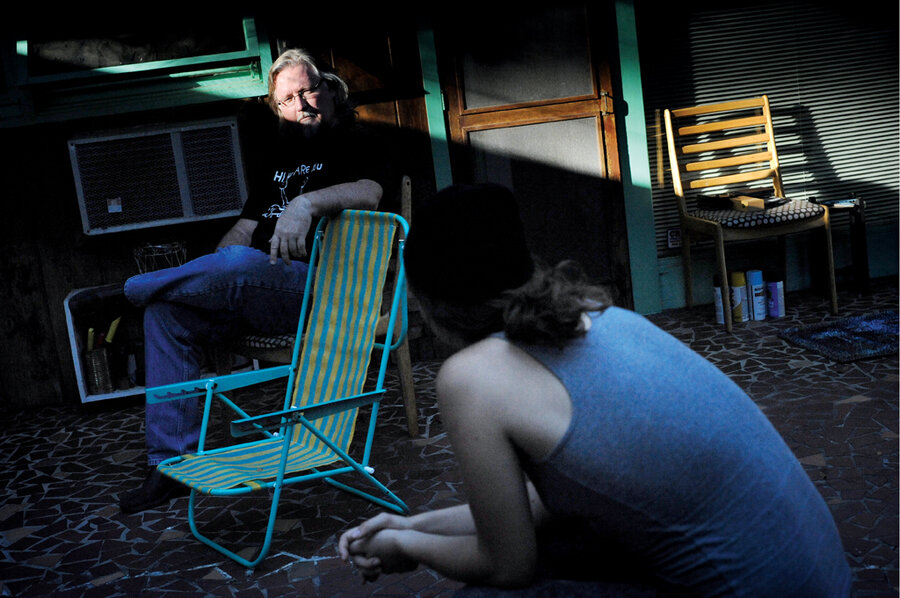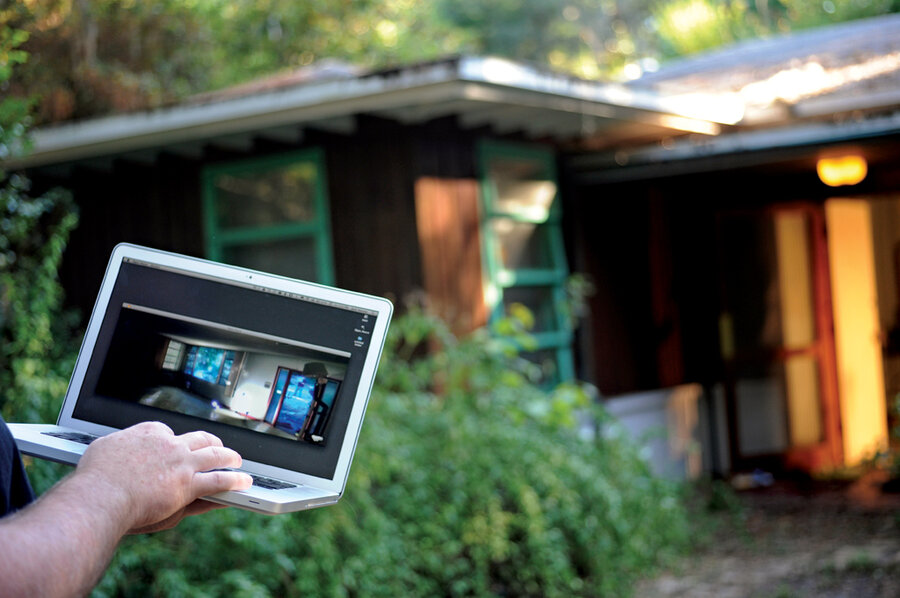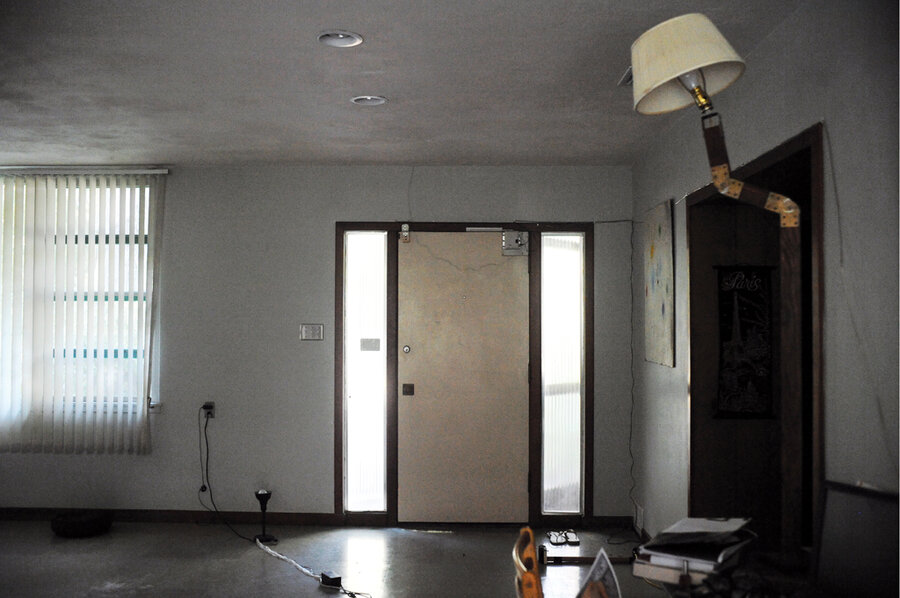Open house: Foreclosure art meets the whims of the web
Loading...
| Gainesville, Fla.
Four years ago, Jack Stenner and his wife purchased a one-story house on Twelfth Road, a quiet boulevard not far from the center of this leafy North Florida town.
The Stenners found much to love about their new home, which had been designed decades earlier by a faculty member at the nearby University of Florida. The living room was roomy and bright, the yard was grassy and sun-dappled, and Mr. Stenner, an assistant professor in digital media at UF, could use the shed out back as a studio.
And yet within a few months, it became apparent the house was less than a perfect fit. Even with only three residents, the kitchen always felt cramped, and contractors had informed Stenner that it would take a lot of cash – and plenty of time – to complete the conversion of the shed.
So in 2007, the Stenners acquired a second house in Gainesville – without selling the first. In retrospect, it seems like a major tactical error. But this was three years ago, before the phrase "subprime mortgage crisis" had entered the national lexicon. The Stenners figured they'd find someone to lease the Twelfth Road house for a year or two, and eventually put the place on the market.
Cue the spectacular burst of the housing bubble.
Within months, the value of the Twelfth Road house, which the Stenners had purchased for around $300,000, had plummeted by tens of thousands of dollars. "We were stuck with two albatrosses around our neck," Stenner remembered recently. "Our life savings were draining away."
Eventually, after months of missed payments and frantic phone calls, the bank informed the Stenners it would foreclose on the Twelfth Road home. Stenner, who is tall and gregarious and has not lost his native Texan twang, does not deny that he and his wife made a mistake by not selling the property when they could. But he places much of the blame for the current foreclosure crisis on banks and appraisers who continued to "jack up" the prices on properties in North Florida, causing "a major disconnect between the value and the actual house," Stenner said. "It's driven by greed, 100 percent. The people in the financial industry, who sit there tweaking their models and manipulating prices and securitizing loans – I don't think they realize that they're affecting real people."
In the summer of 2009, Stenner began mulling over a piece that would explore that "disconnect" – between virtual markets and the real-life destruction that is often left behind. His idea was simple: He would take his own foreclosed house and surrender it to the whims of Web users – the virtual horde – around the world.
Together with his former student and friend Patrick LeMieux, Stenner set about installing motors on the blinds and the front doors of the house; Stenner and Mr. LeMieux then mounted video cameras around the property. Finally, the pair connected the motors and cameras via a snarl of wires to a central hub in the living room.
Stenner and LeMieux had already collaborated on an installation called Gamespace, which merged virtual and real environments into a single "hybrid" world. Using the Gamespace software, the two artists now began building an application that would allow users to virtually interact with the foreclosed house – to fiddle with the blinds, to open and shut the door, to turn off and on the lights in a very real foreclosed home. They titled the piece "Open House."
At the time, there wasn't a whole lot of foreclosure art being made, and Stenner and LeMieux were able to drum up a lot of interest at UF, which offered them a grant to finish the project. In August, the pair traveled to Germany to participate in the International Symposium of Electronic Art (ISEA).
The plan was to have the piece finished before they arrived in Europe, but LeMieux, who is now a doctoral candidate in art history at Duke University in North Carolina, remembers that he and Stenner spent most of their time in their hotel room, scrambling to tie up loose ends. "We weren't seeing Paris, or Dusseldorf," LeMieux laughs. "We were basically just sitting in our hotel room every day, working hours on end, with one break for dinner." The hard work paid off.
At the ISEA, LeMieux and Stenner displayed "Open House" using a plastic simulacrum of the home on Twelfth Road, which in turn housed an Apple iPhone and a miniprojector. Users were invited to tap the touch screen of the iPhone, and watch, in real time, as the lights flipped on and off in the faraway foreclosed home.
"I would always give all this back story," LeMieux says. "You know, 'The housing collapse happened, blah, blah blah.' And people would nod their heads, because they knew the story. But then there would be this big 'aha' moment when the door opened up. The task then became getting the application in their hands so they would download it. Because it's different when you have an intimate experience with the game."
Today, the "Open House" installation exists wholly online. Spectators can navigate to www.no-place.org/open_house/ (tag line: "There's no place like home") and download an application; from there, they are free to fiddle with the blinds and light switches and front door to their hearts' content.
LeMieux and Stenner estimate that hundreds of people have already downloaded the application, and they anticipate keeping "Open House" open until the sheriff finally arrives at Twelfth Road and shuts the place down for good.
In October, I drove with a photographer the 70-odd miles from Jacksonville to Gainesville. I had spoken only briefly with Jack Stenner before arriving in Florida, and I had imagined the house – as advertised – would be entirely empty. But as we pulled up on a warm fall afternoon, two Mormon missionaries were retreating across the lawn; they told me that there was, in fact, someone in the living room. "That's impossible," I said. The missionaries shrugged.
A few minutes later, Stenner showed up, driving a beat-up BMW coupe. He explained that he and his wife had originally found a couple of renters on Craigslist, but they'd stopped collecting rent, and now the place was full of squatters.
We walked up the driveway, where Abed Usef, a 20-something Palestinian, was climbing onto his motorbike. I asked him if he lived in the house. Mr. Usef shrugged.
"Sometimes," he said. He was in massage school, and crashed on a mattress at Twelfth Road when he needed a place to stay. He and Stenner exchanged greetings, although Stenner did not seem to know Usef.
Inside the house, a young black cat was steering a ball of tape across the floor; the cat was missing half a ear.
"Whose cat?" I asked Stenner.
"One of the squatters', I guess," he said.
We sat at the counter, and Stenner opened his laptop. Using the "Open House" application, he swung the door open and shut a couple of times. The motors were on a delay, and the experience was an eerie one – first, Stenner would manipulate the virtual door, and several seconds later, we heard the real door creak open. "A few weeks ago, I saw the mailman coming up the walk, and I waited until he got to the door, and then I swung it open, and shut it again," Stenner said. "You should have seen the guy's face."
I left Stenner with the photographer and walked toward the back of the house, where Kathryn Miller, another massage-school student, was waking up from a nap.
Ms. Miller has lived in foreclosed houses before, and she did not seem particularly ruffled to be living in this one. She had become accustomed to the fact that the doors and windows of the house would spring to life, unprompted. "Really scared me the first time," she said. "Not anymore."
Later, LeMieux would tell me that the fact that squatters had taken over the house added a new and interesting dimension to "Open House." "It feels right to me," he said. "It changes the object of the game somewhat. It makes it into a haunted house, and allows you to have disembodied relationships with [the squatters]."
I headed out the front door, where a banana spider the size of a child's palm was lounging in the afternoon light. The street was empty, save for a middle-aged woman and her dog. I asked the woman if she knew the house was a large-scale art exhibit.
She looked surprised. "I knew something was going on in there," she said. "I always see these people coming and going, but I never say anything to anyone." I asked her if I could use her name, and she demurred.
"Oh, no," she said, and started backing down the street. "I don't want to get anyone in trouble."
Behind us, the door of the house on Twelfth Road opened and shut with a loud crack, and all of us – me, the woman, and her dog – jumped 10 feet in the air.







